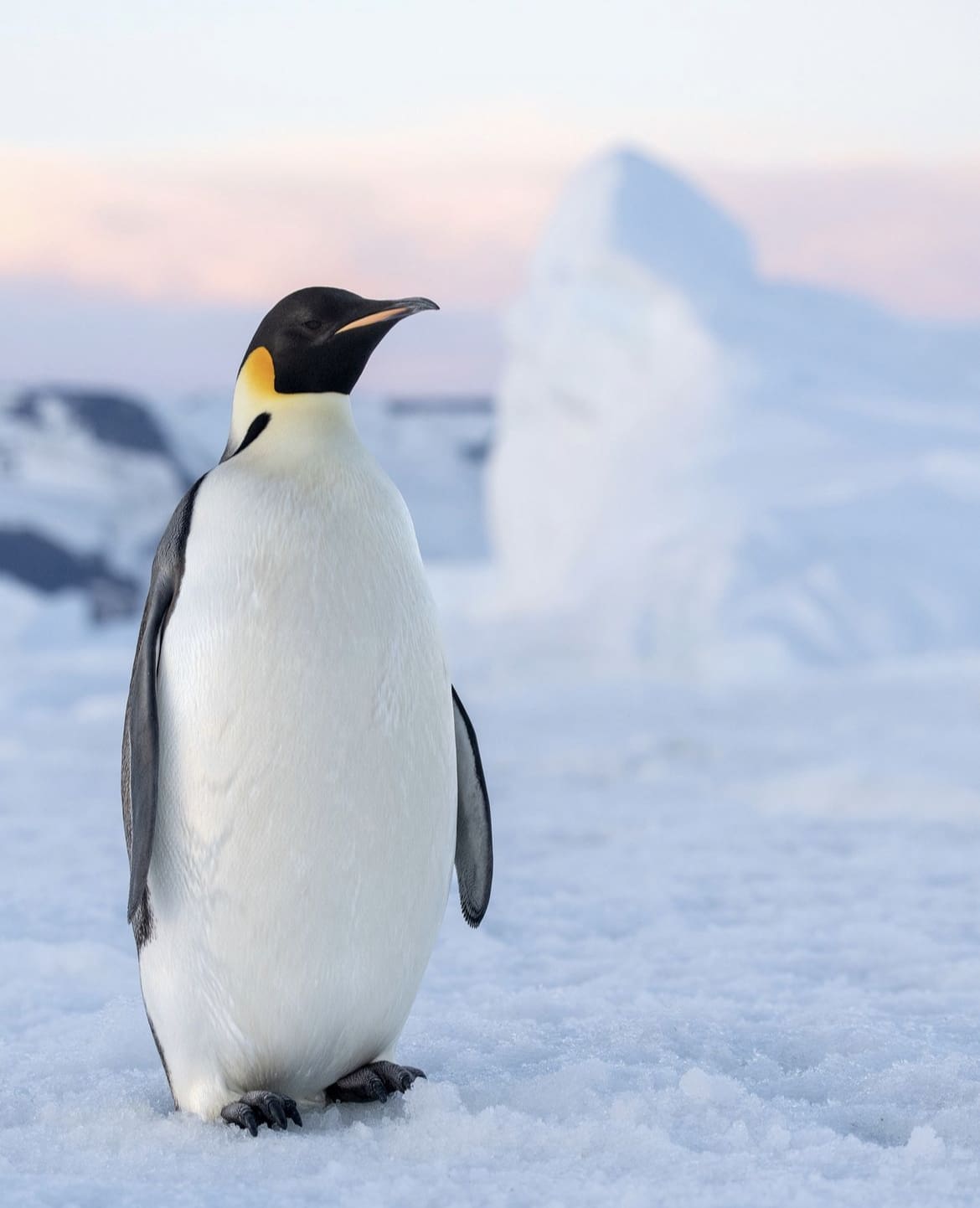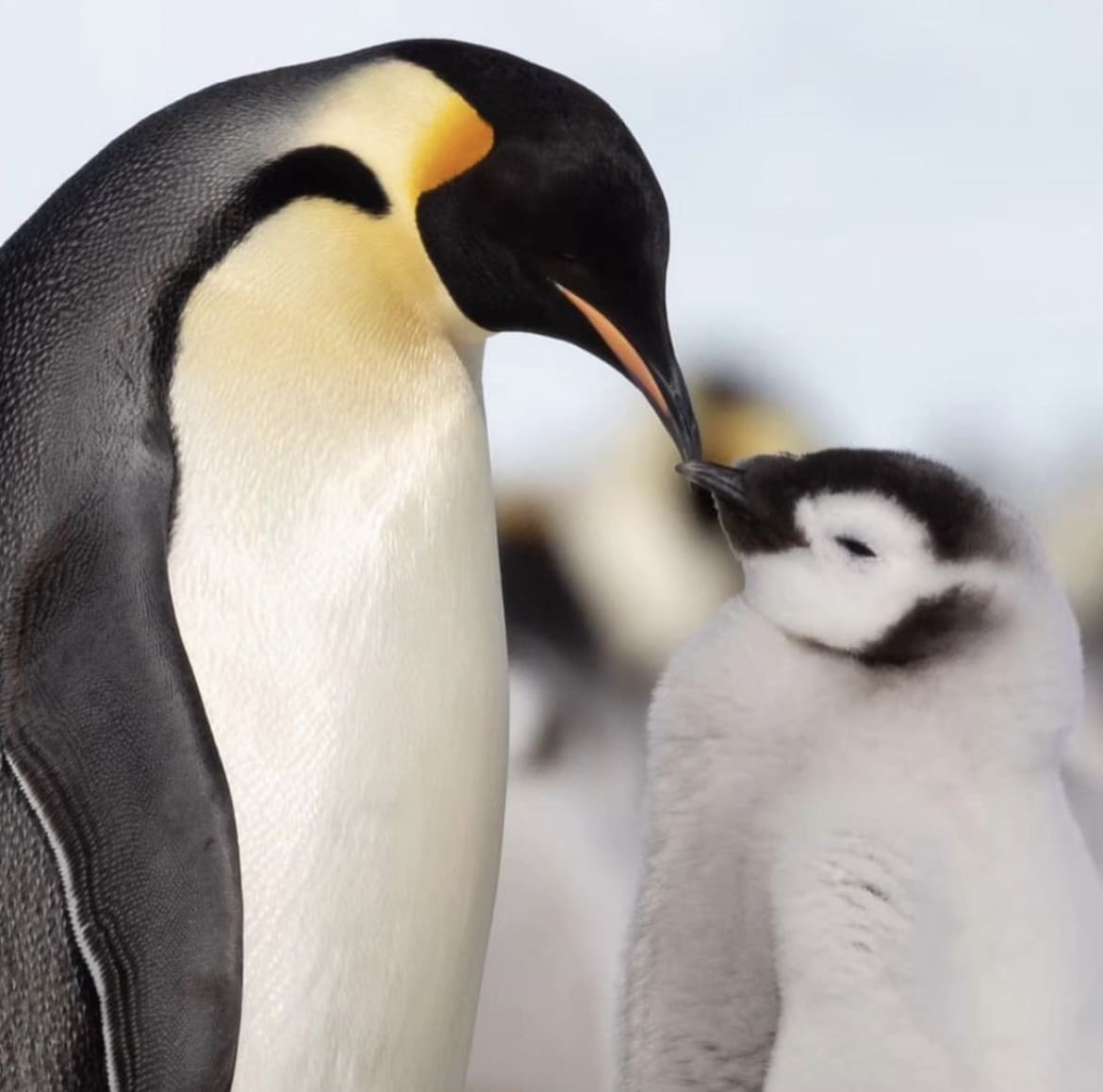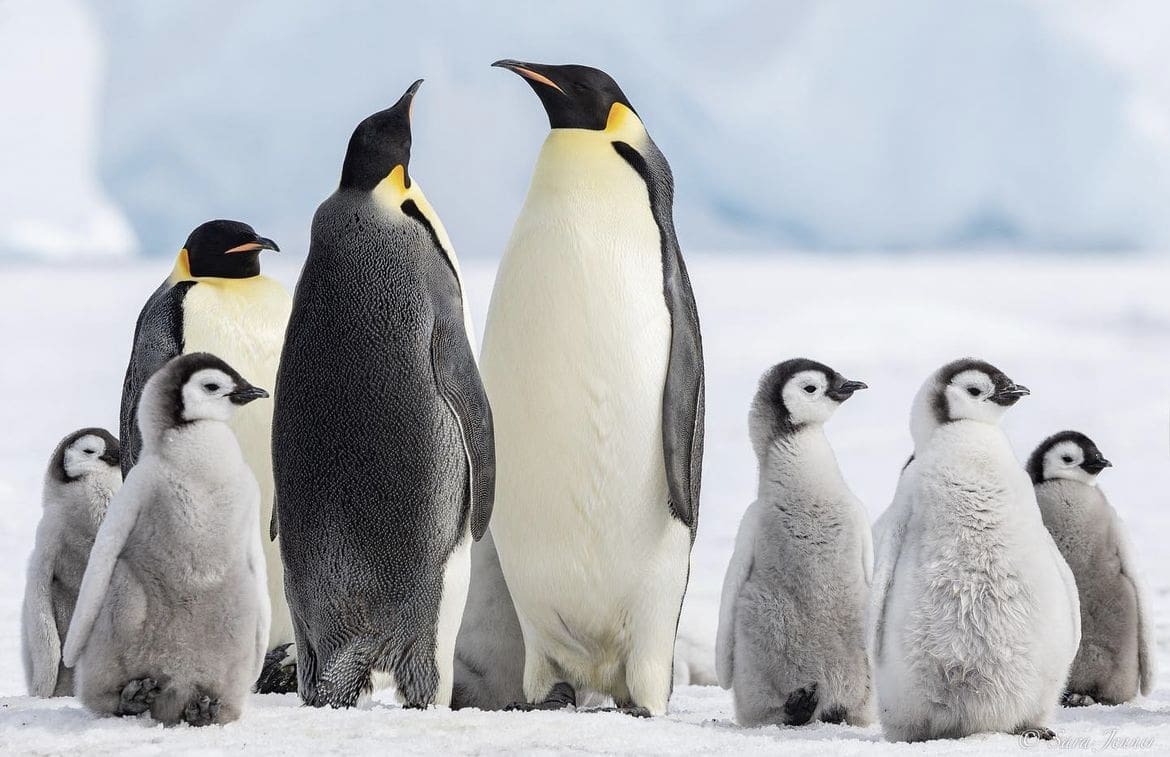The Emperor Penguin – the towering figure of the Antarctic, the heavyweight champion of the penguin world, and frankly, the closest thing we’ve got to a real-life Happy Feet protagonist.
If you’ve ever wondered about these tuxedo-sporting birds that seem to thrive in conditions that would have the rest of us crying for a hot cocoa and a heated blanket, you’re in for a treat.
Let’s dive deep into the icy waters and get up close and personal with the Emperor Penguin. Trust me, it’s cooler than you think (pun absolutely intended).
What is the Emperor Penguin?
First off, the Emperor Penguin (Aptenodytes forsteri, if you’re fancy) is not your average bird. Forget what you know about flying; these guys have swapped air for water, wings for flippers, and tropical breezes for blistering cold winds. Standing tall at up to 120 cm (that’s about 4 feet for the metrically challenged), they’re the largest of their kind.
You might think their life is all about waddling and sliding on ice, but these birds have a drama-filled existence that could rival any soap opera – from epic migrations to parenting feats that defy the elements.

Emperor Penguin vs King Penguin
Now, it’s easy to mix up the royals, so let’s set the record straight: Emperor Penguins and King Penguins are like cousins from the same chilly reunion. While both majestic, the Emperor Penguin is the larger and more, well, emperor-like of the two. Emperors sport a striking black and white coat with a splash of yellow and orange around their necks, giving them a regal aura. Kings, on the other hand, are a bit smaller and rock a sleeker silhouette with more pronounced orange ear patches.
The real drama unfolds in the Antarctic, where Emperors brave the harshest winter on Earth to breed, while Kings prefer the slightly less freezing shores of the sub-Antarctic. Emperors lay their single egg in the dead of winter, passing it between their feet and a special brood pouch to keep it warm, all while fasting and braving blizzards. Kings, though, they’re more about that springtime love, with a breeding season that’s a bit more forgiving weather-wise.

What Do Emperor Penguins Look Like?
Picture this: a bird that’s as tall as your kitchen counter, dressed in the slickest tux you’ve ever seen. Emperors have this dignified air about them, with sharp black and white contrasts that make their yellow neck accents pop. Their beady eyes, set in a stout head, give them a look of curiosity mixed with a hint of “I’ve weathered storms you wouldn’t believe.”
They’re not just about looks, though. Their bodies are built like submarines – sleek, streamlined, and ready to rocket through the water at speeds that would make Olympic swimmers envious. And those flippers? They’re not just for show. These birds can dive deeper than 500 meters (that’s over 1,600 feet!) in search of a good meal. So, next time you’re feeling proud of your pool laps, remember there’s a penguin out there who could swim circles around you – literally.
How Big Are Emperor Penguins?
When we talk about the size of the Emperor Penguin, we’re not messing around. These birds can tip the scales at up to 40 kilograms (that’s about 88 pounds for those of us not on the metric system) and stand as tall as 120 centimeters (nearly 4 feet).
To put that in perspective, imagine a linebacker in a penguin suit, and you’re getting close. This size isn’t just for show; it plays a crucial role in their survival, helping them retain heat and dive deep into the ocean to fish. Size really does matter in the Antarctic.
Emperor Penguin Skin
Now, onto the skin – it’s not something most of us think about when we picture a penguin, but it’s a game-changer for these icy dwellers. Underneath that sleek, waterproof coat of feathers lies a layer of skin backed by a thick layer of blubber.
This isn’t your average fat; it’s a high-tech insulator that keeps them warm in freezing temperatures and during those deep, chilly dives. Think of it as nature’s wet suit, perfectly designed for the cold-water surfer that is the Emperor Penguin.

Emperor Penguin Wings
And then there are the wings, or as they should be more accurately called, flippers. These aren’t your typical bird wings; they’re evolved for the water, not the air. Stiff, flat, and powerful, these flippers are the Emperor’s ticket to agility and speed underwater.
When they hit the ocean, they transform from waddling comedians on ice to sleek, graceful swimmers, darting through the water with the ease of torpedoes. They use these flippers to propel themselves deep beneath the surface, reaching depths where no human could swim without a submarine.
Watching an Emperor Penguin swim is like watching a ballet dancer perform – if the stage was the vast, open ocean.
Emperor Penguin Feet
When you think of the Antarctic, you probably picture a world of ice and snow, a realm where only the hardiest survive. Emperor Penguins’ feet are a testament to this resilience. Unlike what you might expect, their feet are not prone to freezing, despite constant exposure to the icy ground.
This is thanks to a complex system of blood vessels that act as a counter-current heat exchanger. Warm blood heading to the feet warms the cold blood returning to the heart, ensuring their feet stay just above freezing without losing precious body heat. These feet are not only about warmth; they’re also designed for traction on ice, enabling penguins to waddle, hop, and slide on their bellies with surprising agility.
Emperor Penguins have mastered the art of moving on ice, turning what could be a slippery ordeal into an art form.
Emperor Penguin Colouration
The Emperor Penguin’s coloration is as functional as it is striking. Their iconic black and white tuxedo isn’t just for show—it plays a crucial role in their survival. The dark back and white front serve as camouflage in the water, a technique known as countershading.
From below, their white bellies blend with the bright surface water, making them harder to spot by predators and prey alike. From above, their darker backs merge with the ocean depths.
This coloration also plays a role in social signaling, with their vibrant yellow and orange neck patches standing out against the snow, helping them identify each other during the breeding season.
Emperor Penguin chicks attempting to climb an iceberg in search of fresh snow to eat | @davidmerron
What Do Emperor Penguins Eat?
The diet of the Emperor Penguin is as fascinating as their lifestyle. These birds are adept hunters, diving deep into the icy waters to feast on fish, krill, and squid. Their ability to dive over 500 meters deep and hold their breath for more than 20 minutes is nothing short of astonishing.
This isn’t just a casual swim; it’s a high-stakes hunt where speed, agility, and precision are crucial. The Emperor Penguin’s diet is a testament to their adaptation to the Antarctic environment, relying on the rich, cold waters to provide them with the nourishment they need to survive, breed, and raise their chicks.
Emperor Penguin Social Structure
Emperor Penguins are the epitome of community spirit. Unlike the solitary creatures that roam the icy landscapes of Antarctica, these penguins find strength in numbers. During the harsh winter months, when temperatures can plummet to a bone-chilling minus 60 degrees Celsius, they huddle together for warmth in what can only be described as a feathery mosh pit.
This huddle isn’t just a random gathering; it’s a highly organized, constantly shifting formation that ensures each penguin gets a turn in the center, where it’s warmest, and on the outer edges, where it’s coldest. This social behavior showcases their incredible cooperation and ensures their survival in extreme conditions.
How Do Emperor Penguins Reproduce?
The reproductive cycle of the Emperor Penguin is a story of endurance and dedication that puts most romantic tales to shame. The process begins in the dead of winter, when temperatures are at their most brutal, and the ice is solid enough to support their breeding colonies. After a courtship filled with intricate dances and duets, females lay a single egg and then embark on a two-month-long feeding journey back to the sea, leaving the males to perform the incredible feat of incubating the egg.
Balancing the egg on their feet and covering it with a warm layer of skin called the brood pouch, male Emperor Penguins stand vigilant against the Antarctic freeze, fasting and surviving on their fat reserves. This period of incubation is a true test of endurance; the males huddle together for warmth, weathering blizzards and enduring the biting cold, all while ensuring the next generation is safely brought into the world. It’s a remarkable display of parental investment that’s unmatched in the animal kingdom.

How Long Do Emperor Penguins Live?
Life in the extreme Antarctic is not for the faint of heart, yet Emperor Penguins have adapted to not just survive, but thrive in these conditions. On average, these resilient birds can live up to 20 years in the wild, a testament to their remarkable adaptations and the robustness of their species.
This lifespan, while impressive, is fraught with challenges from the very beginning, from evading predators like leopard seals and orcas to navigating the drastic changes in their environment due to climate change.
The longevity of the Emperor Penguin is a delicate balance, maintained through their incredible social behaviors, efficient hunting skills, and unparalleled endurance.
Are Emperor Penguins Aggressive?
When picturing the Emperor Penguin, aggression rarely comes to mind. These creatures are the epitome of the phrase “cool, calm, and collected.” In their harsh Antarctic habitat, cooperation often trumps competition.
However, like any animal, they have their moments—especially during the breeding season when males might engage in some beak-to-beak or flipper-to-flipper action to protect their precious standing ground or their mate. But, let’s be clear: these skirmishes are more about posturing than actual fierce battles.
Outside of these breeding squabbles, Emperor Penguins are remarkably peaceful, working together to survive the extreme cold. They understand that unity is strength, especially when facing the unforgiving conditions of their icy home.
Are Emperor Penguins Territorial?
In the vast expanses of Antarctica, where ice and sky merge into one, Emperor Penguins stand together against the elements. Territoriality, in the human sense, isn’t a part of their social structure.
They don’t defend specific patches of ice or sea; their survival strategy is based on unity and mobility rather than territory. During breeding season, they gather in colonies that can number in the thousands, but these gatherings are more about collective warmth and shared parenting duties than about laying claim to a piece of the frozen desert.
Once their breeding and rearing duties are over, they disperse into the ocean, where the concept of territory fades into the endless blue. Emperor Penguins embody a spirit of adaptability and community, understanding that their strength lies in numbers, not in the defense of a particular ice floe.

Do Emperor Penguins Eat People?
To set the record straight: no, Emperor Penguins do not eat people. Their diet is strictly seafood-based, comprising fish, krill, and squid caught in the icy waters of the Antarctic. This question, while unusual, gives us a chance to reflect on the relationship between humans and these majestic birds. Emperor Penguins are curious by nature and have been known to approach research teams and explorers with what can only be described as an innocent fascination.
These interactions, always under strict guidelines to ensure minimal disturbance, highlight a mutual curiosity rather than any hint of aggression or predatory intent. In the vast, open wilderness of Antarctica, Emperor Penguins see humans as oddities in their environment, not as a potential menu item.
Where Do Emperor Penguins Live?
The Emperor Penguin calls the vast, frozen continent of Antarctica home, specifically the outer coastal regions where ice meets the sea. These birds are uniquely adapted to life in this extreme environment, one of the harshest on Earth. Unlike other penguin species that might seek out warmer or more temperate zones, Emperors thrive in the cold, leveraging the Antarctic’s icy landscape for breeding, feeding, and socializing.
Their colonies are situated on the sea ice, which serves as a stable platform for breeding and as a launching pad for their deep-sea dives in search of food. The exact location of these colonies can vary from year to year, depending on the condition of the sea ice, highlighting the Emperor’s incredible adaptability to the dynamic Antarctic environment.
How Do Emperor Penguins Survive the Cold?
Surviving the Antarctic’s extreme cold requires a suite of highly specialized adaptations, and the Emperor Penguin has evolved a remarkable set of traits to this end. Their feathers, for starters, are densely packed and provide waterproofing as well as insulation, trapping a layer of warm air close to the skin. Underneath their sleek exterior, a thick layer of blubber acts as an additional insulator, conserving body heat even in the most frigid waters.
One of their most fascinating adaptations is their behavior of huddling together for warmth. These huddles can include thousands of penguins standing so close that their bodies form a single mass, conserving heat and protecting each other from the biting wind and cold. This social warmth-sharing is crucial during the breeding season when temperatures plummet, and the Antarctic winter is at its most fierce. Furthermore, their circulatory system is adapted to minimize heat loss, with special mechanisms that allow for the counter-current exchange of heat between arteries and veins.
How Many Emperor Penguins Are There in the Wild?
Estimating the population of a species that lives in one of the most inaccessible places on Earth is no small feat. However, recent studies and satellite imagery have helped scientists get a better handle on the number of Emperor Penguins. The global population is estimated to be around 270,000 to 280,000 breeding pairs, which translates to roughly 550,000 to 560,000 individuals.
Despite this seemingly large number, the Emperor Penguin’s population faces significant threats from climate change, which affects the extent and stability of the sea ice they rely on for breeding and feeding. Changes in sea ice patterns can lead to habitat loss and reduced access to food sources, posing a long-term threat to their populations. Conservation efforts and ongoing research are crucial to understanding and mitigating these impacts, ensuring that these magnificent birds can continue to thrive in their icy world.
Are Emperor Penguins Endangered?
The conservation status of the Emperor Penguin has become a growing concern amidst the accelerating impacts of climate change. As of my last update, the International Union for Conservation of Nature (IUCN) listed the Emperor Penguin as “Near Threatened,” reflecting the increasing vulnerability of their population to environmental changes.
The primary concern is the loss of Antarctic sea ice due to rising global temperatures, which directly impacts their breeding and feeding grounds. This status is a call to action, emphasizing the need for comprehensive climate policies and conservation efforts to protect these iconic symbols of the Antarctic.
Threats to Emperor Penguins in the Wild
The majestic Emperor Penguin faces several significant threats, with climate change at the forefront. The warming climate leads to the melting of sea ice, crucial for their breeding and foraging. Without stable ice, Emperor Penguins cannot successfully breed, rear their chicks, or access their primary food sources. Additionally, changes in the Antarctic ecosystem can affect the abundance and distribution of krill, a staple in the Emperor Penguin’s diet, further complicating their survival.
Other threats include industrial fishing, which can deplete their food sources, and potential oil spills, which could devastate their pristine environment. The cumulative impact of these threats underscores the urgency of implementing effective conservation strategies to ensure the Emperor Penguin’s survival.

Where to See Emperor Penguins In the Wild
For those yearning to witness the majesty of Emperor Penguins in the wild, there are specific locations in Antarctica where this is possible. Tours typically depart from Ushuaia, Argentina, offering a once-in-a-lifetime opportunity to observe these birds on the ice. Popular spots include the Weddell Sea and the Ross Sea, where visitors can see Emperor Penguin colonies in their natural setting. However, it’s crucial to choose eco-friendly tours that minimize human impact on their habitat. Observing these creatures from a respectful distance ensures their wild behavior remains undisturbed by human presence.
Tips for Spotting Emperor Penguins
Spotting Emperor Penguins requires patience, respect for their environment, and a bit of luck. The best time to visit is during the Antarctic summer, from November to February, when the ice is more navigable, and the penguins are not deep into their breeding cycle. Dress warmly, bring binoculars for distant viewing, and always follow the guidelines set by your tour operator to avoid disturbing the wildlife. Remember, the goal is to observe these magnificent creatures without impacting their natural behavior.
Facts about The Emperor Penguin
- They are the tallest and heaviest of all penguin species.
- Emperor Penguins can dive deeper than any other bird, reaching depths of over 500 meters.
- They have a unique adaptation that allows them to recycle their own body heat to breathe in the extreme cold.
- The male Emperor Penguin incubates the egg through the Antarctic winter, fasting for up to two months.
Myths about The Emperor Penguin
- Myth: Emperor Penguins mate for life. Reality: While they are monogamous within a breeding season, they may choose different partners in different seasons.
- Myth: They can live in the North Pole. Reality: Emperor Penguins are exclusively found in Antarctica, the South Pole.
- Myth: They are only black and white. Reality: Emperor Penguins have yellow and orange markings around their necks, giving them a distinct appearance.
